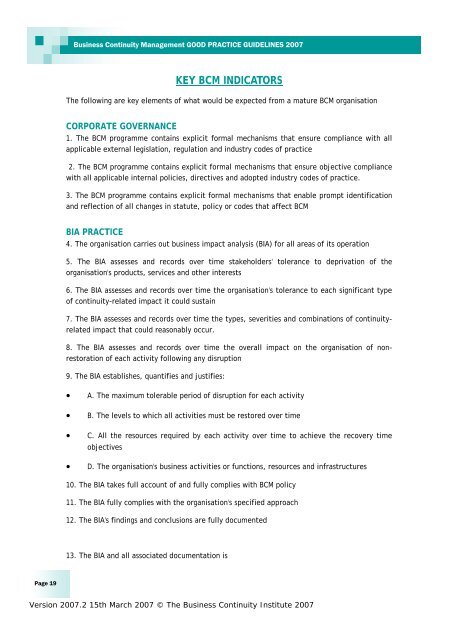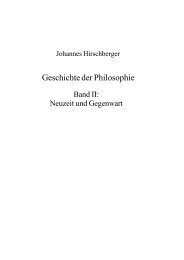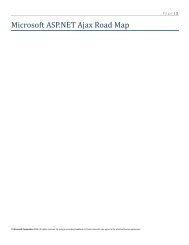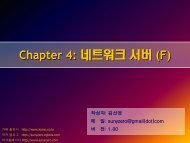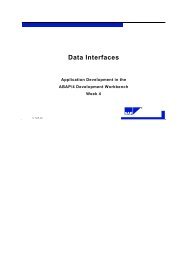business continuity institute good practice guidelines 2007
business continuity institute good practice guidelines 2007
business continuity institute good practice guidelines 2007
You also want an ePaper? Increase the reach of your titles
YUMPU automatically turns print PDFs into web optimized ePapers that Google loves.
Page 19<br />
Business Continuity Management GOOD PRACTICE GUIDELINES <strong>2007</strong><br />
KEY BCM INDICATORS<br />
The following are key elements of what would be expected from a mature BCM organisation<br />
CORPORATE GOVERNANCE<br />
1. The BCM programme contains explicit formal mechanisms that ensure compliance with all<br />
applicable external legislation, regulation and industry codes of <strong>practice</strong><br />
2. The BCM programme contains explicit formal mechanisms that ensure objective compliance<br />
with all applicable internal policies, directives and adopted industry codes of <strong>practice</strong>.<br />
3. The BCM programme contains explicit formal mechanisms that enable prompt identification<br />
and reflection of all changes in statute, policy or codes that affect BCM<br />
BIA PRACTICE<br />
4. The organisation carries out <strong>business</strong> impact analysis (BIA) for all areas of its operation<br />
5. The BIA assesses and records over time stakeholders' tolerance to deprivation of the<br />
organisation's products, services and other interests<br />
6. The BIA assesses and records over time the organisation's tolerance to each significant type<br />
of <strong>continuity</strong>-related impact it could sustain<br />
7. The BIA assesses and records over time the types, severities and combinations of <strong>continuity</strong>related<br />
impact that could reasonably occur.<br />
8. The BIA assesses and records over time the overall impact on the organisation of nonrestoration<br />
of each activity following any disruption<br />
9. The BIA establishes, quantifies and justifies:<br />
• A. The maximum tolerable period of disruption for each activity<br />
• B. The levels to which all activities must be restored over time<br />
• C. All the resources required by each activity over time to achieve the recovery time<br />
objectives<br />
• D. The organisation's <strong>business</strong> activities or functions, resources and infrastructures<br />
10. The BIA takes full account of and fully complies with BCM policy<br />
11. The BIA fully complies with the organisation's specified approach<br />
12. The BIA's findings and conclusions are fully documented<br />
13. The BIA and all associated documentation is<br />
Version <strong>2007</strong>.2 15th March <strong>2007</strong> © The Business Continuity Institute <strong>2007</strong>


